Organize Your Thoughts & Your Desk with Desktop Whiteboards
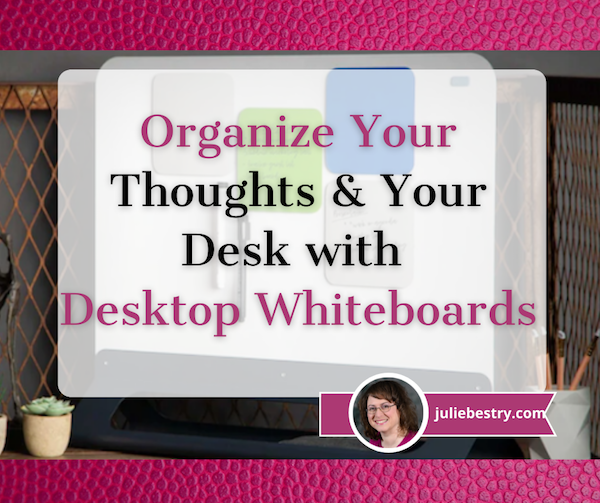
Over the last two years, we’ve understandably seen a vast increase in people working from home. As they’ve done so, they’ve transitioned from those early ad hoc set-ups at the dining room table using chairs better suited for celebrating Thanksgiving than spending eight hours in front of a computer. Little by little, we’ve all added the items that made office work, if not outright enjoyable, at least little more efficient and comfortable.
However, a number of my clients who’ve fully embraced working from home have commented that they miss whiteboards. For some, it’s the collaborative nature; for others, it’s the ease of grabbing a chunky pen and writing on something fixed-in-place.
The impermanence of the words — let’s face it, a whiteboard is just a dry-erase board with a 21st century title — doesn’t seem to bother most people because of the sense of the fixed-in-place aspect of the whiteboards themselves. A loose piece of paper may get buried; a sticky note might flutter into the trash. But a note on a whiteboard stays until you wish it to depart.
However, even if you’ve made your dining room, spare bedroom, or other space in the house into an office, complete with desk and chair, lighting and filing space, you may not have invested in a whiteboard like you had in your olden-days office. But have you considered a desktop whiteboard?
BENEFITS OF DESKTOP WHITEBOARDS
While a desktop whiteboard isn’t always a perfect solution, it can have appealing advantages. A desktop whiteboard is (or can be):
Installation-free — Maybe you’re handy, but Paper Doll is not. My walls are embarrassingly bare, as even though I can find a stud (no jokes, please), the sheetrock in my apartment is pretty “meh.” I’d rather not hang or install anything too heavy. Plus, if your office is in a highly visible area of your home, you may not want a massive whiteboard clashing with your decor. Instead of installing a whiteboard on the wall, opting for a smaller profile item might be appealing.
Portable — Do you need to be mobile? Depending on your work style, you may move around your home or sometimes set yourself up in coffee houses or co-working spaces. If you’re a student, you may split your time between your home or dorm desk and your carrel at the university library.
And even if you do go into the office, more and more companies are going hybrid and eliminating assigned desks, opting for hot-desking where you work at a different desk each time you come in. With all of these situations, wouldn’t having a portable whiteboard you can use on your desk be a nice option?
Analog — To be sure, I’m a big fan of digital note-taking. Have I mentioned that I just completed re-certification as an Evernote Certified Expert?

However, for a lot of us, tiny bits of information need to stay in front of us for almost-immediate use. There are many times where we just want to quickly capture a phone number, name, turn of phrase, or concept, and the fastest way to do this is by grabbing a pen and writing it down.
I’m a pacer — when I’m on the telephone and really in sync with the person with whom I’m conversing, I can get most of my 10,000 Fitbit steps a day logged while chatting and pacing the room. While I could definitely go back to my desk, sit down, open a task app or Evernote screen, it’s going to be more convenient for me to scribble on a small whiteboard.
Sure, I could write on a sticky note, but on a busy day, that might lead to a snowstorm of stickies across my desk, which isn’t particularly eco-friendly.
And yes, I could take advantage of the newest Evernote feature, Evernote Helper to make a quick note. If you’ve got Evernote running in the background, just click Control + Command + H on a Mac or Control + Alt + H on a Windows PC, then type (or copy & paste) information into the resulting mini-note; clicking anywhere else on the screen takes you back to what you were doing and the note hides until you want or need it. I could explain further, but my buddy Dr. Frank Buck created a whole video post on this very topic.)
My point, and I do have one, is that there are times when an analog approach to capturing small pieces of information works best, and a whiteboard can be the way to do it.
Motivational — Again, yes, a digital approach can be motivational. On my iPhone, a reminder to be mindful pops up on my screen (with an associated ding) every time I get out of the car. It asks me, “What are you tolerating?” to help me align with the concepts I discussed in Organize Away Frustration: Practice The Only Good Kind of “Intolerance.”
On my Mac, when I hit F3 to get to my little dictionary app, I also get a screen of inspirational digital sticky notes I’ve created, like these:
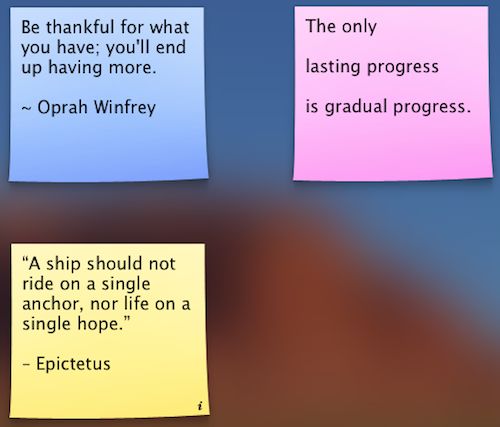
But back in ye olden days when I worked in television, I had a whiteboard on one wall and a bulletin board on another. As with most people, I let my bulletin board get cluttered, but my whiteboard served as an ideal spot to write the message of the day, whether it was one word, like RESILIENCE, or an entire message, like, “I have radical trust in the perfect unfolding of my life,” as we talked about in The Perfect Unfolding As We Work From Home.
Environmentally-appealing — Last week was Earth Day, so sustainable products have been on my mind. We should note that not all whiteboards are equally Earth-friendly. Most whiteboards are made of one of three types of materials: glass, porcelain, or melamine. Glass, obviously, is recyclable. Porcelain whiteboards (often made of ceramics with steel or aluminum backing to make them magnetic) are not easily recycled; melamine is not recyclable at all.
If sustainability is important to you, consider these factors when you pick any whiteboard option. (And check out the nifty steel options discussed later in this post!)
PREVIOUSLY ON PAPER DOLL
Last year, in Paper Doll Models the Spring 2021 Organizing Products, while looking at the the Quartet Portable Glass Dry-Erase Pad, I found something nifty on a grander scale. At the time, I wrote the following.
Quartet Desktop Glass Whiteboard Computer Pads
Quartet‘s Desktop Glass Whiteboard Computer Pads are just as environmentally friendly as their portable cousins, but they are designed to be used at the computer, where there’s far less chance of dropping them! (What?! I can’t be the only person who fears being klutzy and having a purse full of shattered glass!)
This two-pound, 18″ wide by 6″ high, angled organizing tool does double-duty. The contemporary-style glass top is made of a sleek, durable, dry-erase surface, designed to fit in with any office or home décor.
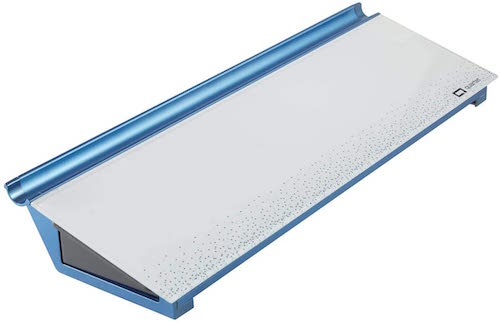
The non-porous glass does not absorb ink, so Quartet guarantees (for 15 years!) that it will not stain or ghost, and it’s made to resist dents and scratches in case you have a cat or tiny human (or co-worker who behaves like either one) visiting your desk. So, write your task list or the phone numbers you’re transcribing from voicemail, erase, write something completely new – all to your heart’s content.
The writing area is only part of what makes the Desktop Glass Whiteboard Computer Pad useful. The item as a whole is designed to sit between your keyboard and your monitor, and the built-in storage drawer slides out to expose space for markers, sticky notes, flash drives, and whatever you want to keep at your desk while maintaining a clutter-free work environment.
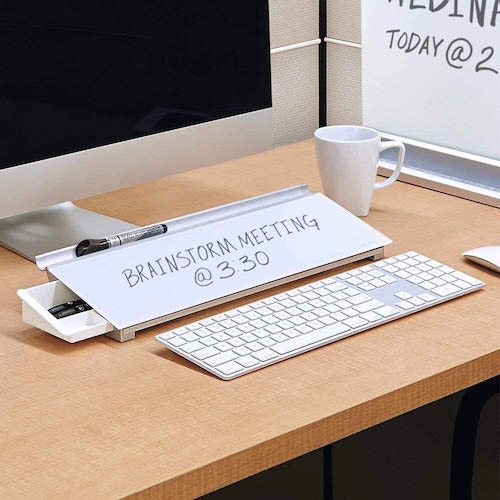
There’s also a small trough at the top of the angled surface where your dry-erase markers can nest comfortably until you write your next reminder.
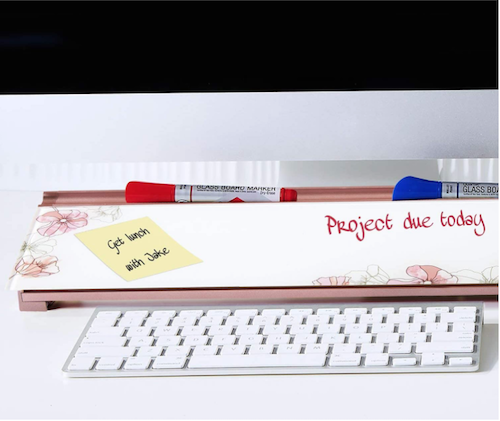
The Quartet Glass Dry-Erase Desktop Computer Pads come in five styles: White, Marble (grey with gold accents), Floral (white with pink accents), Dot (white with blue accents), and Black (with silver accents).
Reviewers advised that while a variety of dry-erase markers will work, the Quartet branded ones seem to have the best staying power and erase the most cleanly, so caveat emptor. I should also note that it’s not immediately obvious what color dry-erase ink colors would be visible on a black background. It appears the black version comes with white dry-erase marker.
The different versions range in price from $31-$40 on the Quartet website, and $29-$44 on Amazon.
Since the time I published that post, there’s been an explosion in the popularity and availability of desktop whiteboards. There hasn’t been this much excitement in the world of whiteboards since Tim Russert’s “Florida, Florida, Florida” in 2000!

A BUFFET OF OPTIONS FROM FLUIDSTANCE
You might recognize Fluidstance from their ubiquitous balance board ads on Facebook, but I’ve become fascinated by their ever-increasing desktop products.
Fluidstance Slope Personal Desktop Whiteboard
First up is their Slope Personal Desktop Whiteboard, which takes an upscale twist on the usual whiteboard product. It’s not glass, porcelain, or melamine: it’s 100% heavy-duty steel (so it’s magnetic), and powder-coated using a low-emissions process.

Manufactured in California, Fluidstance says Slope’s design is inspired by “an open, groomed ski run.” The angle is gentle for ease of writing and the top dry-erase surface is described as “premium.” Unlike the Quartet version, it doesn’t have a cubby for supplies, but it does have a channel at the top to nestle dry-erase markers and any other writing implements.
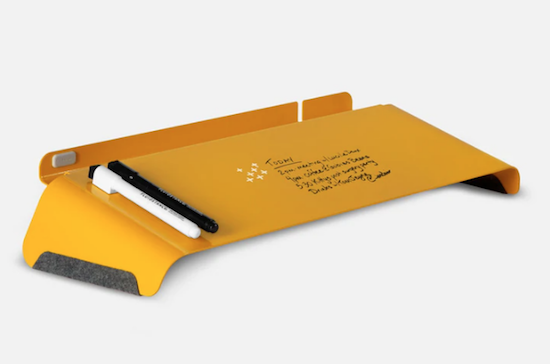
Slope’s raised surface lets you slide your keyboard underneath for storage, so you can free up space on you desk for when you’re having lunch (but seriously, don’t have lunch at your desk — get some fresh air!) or doing some other analog writing.
There are felt bumpers to protect your desk from scratches or other marks, and it (and all of the Fluidstance products mentioned below) comes with a microfiber eraser pouch in which the dry-erase pen is packed.
And, as of last month, Slope comes with a free silicone phone holder crafted to fit within the pen channel and keep your desk tidy.
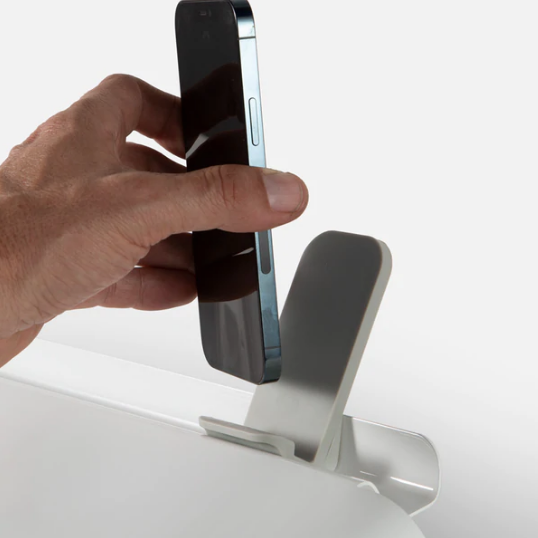
Slope measures 20″ long (18 3/4″ underneath) by 8″ wide by 3 1/2″ high (at the highest point, and 1 1/4″ as the lower, near, end); it weighs about three pounds. Slope comes in five color schemes: White, Blue Steel, Slate (grey), Honeycomb (yellow) and, in a limited edition Sequoia (green); Slope costs $69 at the Fluidstance online store (and at Amazon, where only the white version is available).
Slope (as all their products) comes with a lifetime warranty; they will repair or replace items for free.
Fluidstance also has a Slope+ for $99 with all of the features of the Slope, plus a phone charger.
Fluidstance Edge
Do you write a lot? I mean, not necessarily as much as Paper Doll, but perhaps twice as much as you’d need to write to cover a Slope? I guess some of the folks at Fluidstance have the same issue, as they’ve developed the Edge, which is similar to the Slope, but with a reversible, double-sided writing surface in the same 100% heavy-duty steel.
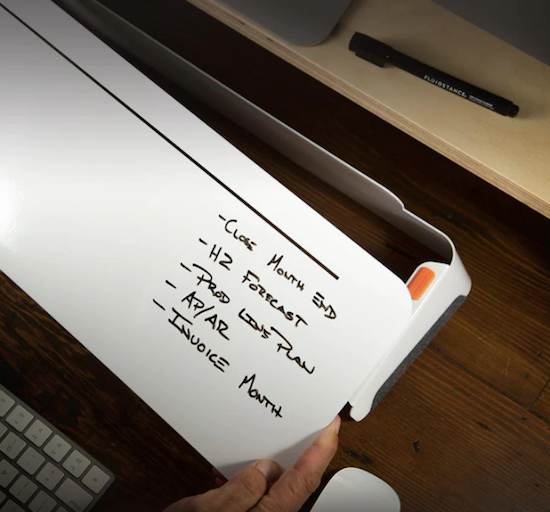
Of course, because it’s double-sided, there’s no marker channel (because, duh, the markers would fall out), and no phone holder. However, the metal base extends up through the writing surface to make a small “fence” where you can rest your markers temporarily.

The Edge comes in white or black-and-white (with a white writing surface and a black metal base); it’s also $69. The measurements are slightly different from the Slope, as shown above.
Fluidstance Lift
The above options are ideal if you’re using a desktop (as I am) or a laptop with an external keyboard. Your little whiteboard fits right in that space between your fingers flying over the keyboard and your computer. But what if you’re using a laptop at a standing desk? What if you should be looking at a monitor that’s up a little higher? Fluidstance has you covered!
The Fluidstance Lift™ is a two-in-one personal whiteboard and laptop riser. It’s designed to improve your ergonomic set-up by “raising your laptop to the ideal height for viewing a primary or secondary monitor” while still giving you a great dry-erase space on a durable, 100% steel, powder-coated platform. Take a look at the video:
There are silicone grommets on the base to hold Lift in place while keeping the desk protected, and there’s a felt pad (made out of 100%-recycled plastic bottles) to nestle your laptop.
The Lift is $79 at the Fluidstance store.
Fluidstance Wall and Flow Cards
If the 100%-steel, magnetic whiteboard appeals to you but you want more elbow room, without having your whiteboard so close to the keyboard or computer, there are yet more options in store. The Fluidstance Wall is a freestanding, double-sided whiteboard wall suitable for sitting on your desk. Consider it a privacy screen combined with a whiteboard, eminently portable for when you’re working in a school library or coffee house or just in a distracting office space.
(For more on privacy screens, whether for safety or productivity, check out last year’s Paper Doll post, Divide and Conquer: Improve Productivity With Privacy Screens.)
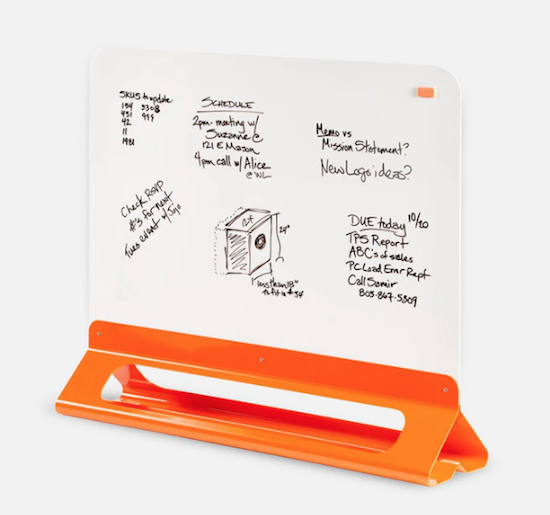
Use Wall on its own as a whiteboard or with Flow Cards (see below), or as a pin-up board with magnets. (Use your own, or get Fluidstance’s pushpin-like versions for $9.)
The base and wall are 24″ wide; the entire set-up measures 20″ high, though the vertical writing surface is just 15″. The base measures 5.6″ front-to-back.
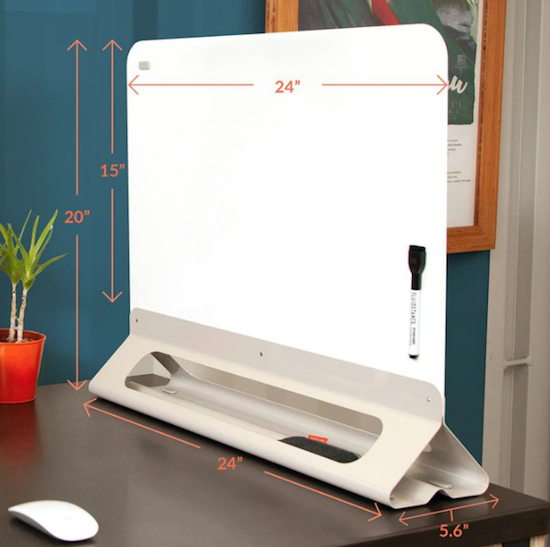
The Wall’s base comes in Blue Matte, Orange, or Grey, and has a 19″ x 2.5″ slot (accessible from all sides) for storing markers, pens, and other desk accessories.
The Wall is $99.
At the risk of sounding like a commercial from the 1980s, but wait, there’s more!
If you want a smaller profile for writing your notes when you’re on the go, or want to combine multiple surfaces with the Wall, you can go either way. Fluidstance’s Flow Cards are four round-edged square, magnetic, dry-erase cards. (You get two grey, one green, and one blue one to a set.)
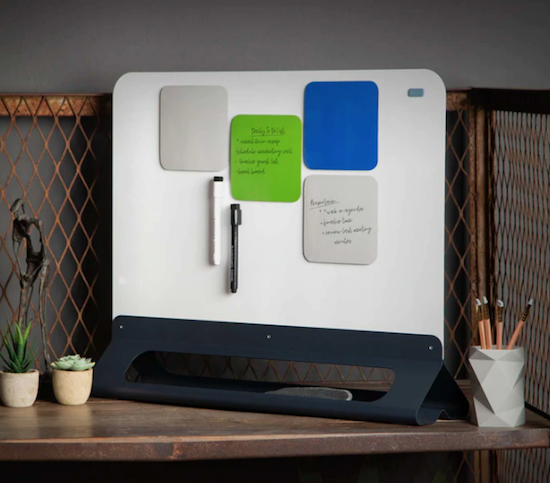
Purchase just the Flow Cards if you want to use them with the Wall, Edge, or Slope, or get a set combined with their 100% steel, white card holder (below).
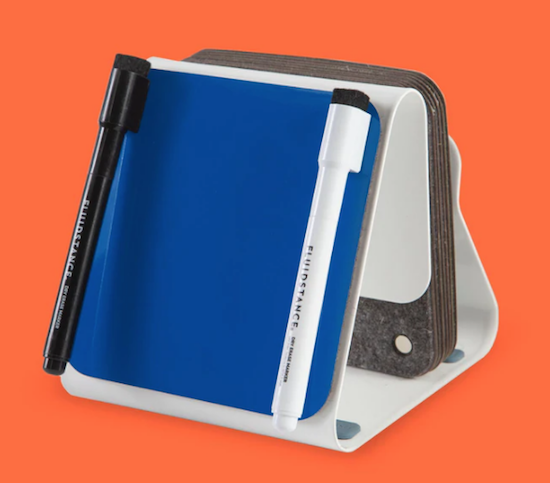
The front of the holder is also a magnetic whiteboard surface, and you can store up to eight Flow Cards in the rear of the holder. So organized!

A set of Flow Cards is $35; a set sold with the holder is $59.
SIMILAR OPTIONS FROM DIFFERENT SOURCES
Did you like Fluidstance’s mixture of a privacy screen and a whiteboard, but you prefer to use your Amazon Prime account for everything?
VIVO Desktop Whiteboard is a freestanding 23″ x 19″ double-sided dry-erase board that also serves as a privacy divider.

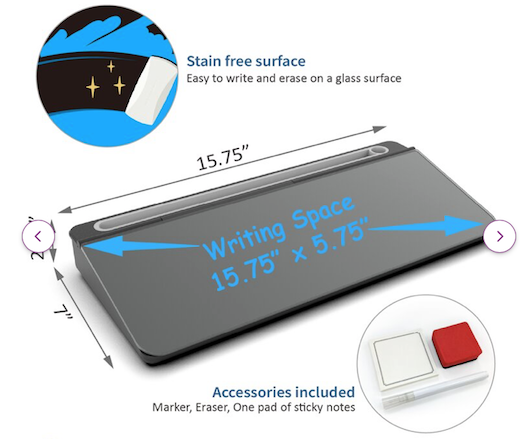
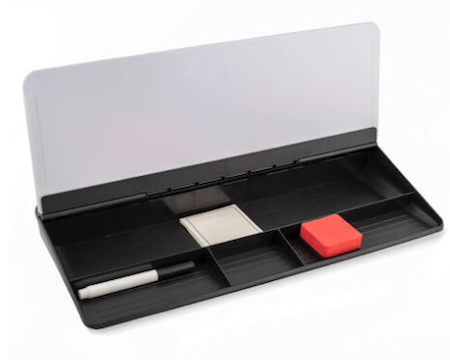
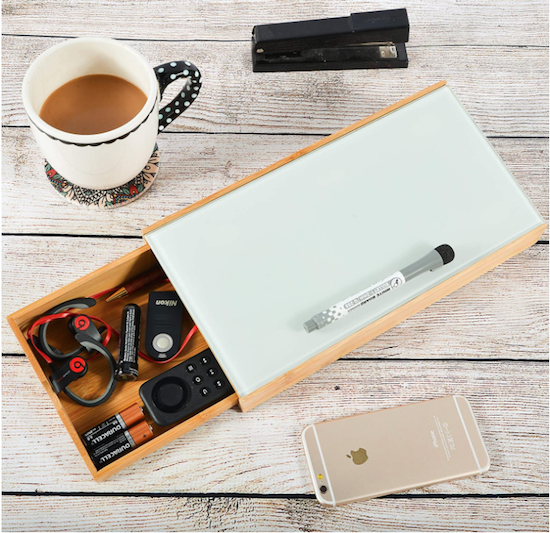




This is the second time today I heard the term “hot-desking.” And I can see how having a portable whiteboard would be useful, especially if you’re constantly moving around where you’re working.
Clearly, the fact that so many smaller whiteboard options exist now means there is quite the demand. It’s funny because I used to have a small white board on the wall near my desk. In the past year or so, I replaced it with a framed drawing of my dad’s.
While I’m not sure I need a whiteboard, if I were going to get one, the small Fluidstance Flow Card holder looks awesome. Something to think about. Thank you for getting my thoughts going for possible uses.
Yeah, hot-desking as a concept has apparently been around since the 1990s, but the use of the term didn’t start to spread until about 7 years ago when call center workers started having to do it. (Nothing makes an awful job worse than not even getting to have possession of your space!) I’m not a fan of the concept, but anything you can do to make your workspace more personalized and efficient has to be a good thing, right?
Now that you’ve replaced your small whiteboard, what do you use instead? Or were you tending to use it for static info and not quick notes?
Thanks for reading and sharing!
Great tips! Having a designated area for the office at home is so vital. I have been working from home for over 15 years, and if I didn’t have my office space dedicated to my work, I don’t think I would have been productive.
I have two self-stick whiteboards on the walls in my office. They are self-stick rolls that you can easily install and remove with no issue. It is wonderful. I have one that is an idea board and the other one holds things like blog ideas and client work activities and time blocking stick note tasks that need completing divided up into 15 min increments so I can pull from them when I have a little or a lot of time.
Making the home office work for each person is very individual, all we need to do is think about what will work best for us. And, then find solutions. This post shares a lot of solutions. Thanks for sharing.
I know what you mean, Sabrina. I don’t think I could stand hot-desking, and even back in college, I preferred working at my desk in my room to hopping around to different libraries. I like continuity in my space.
And an update on stick-up whiteboard sheets and other non-traditional whiteboard items is a topic I’m saving for a future post. I love the way you’re using them for two different purposes!
Thanks for reading and sharing!
Like Linda, I’m learning about “hot-desking.” I guess this is the new thing. I have to say, seems like kind of a hassle for me as an employee. However, that isn’t the topic of this post, so I will move on.
I think whiteboards can serve a nice, niche function. I wouldn’t want to be carrying one around, because I think I would smear the writing or get it on my clothes. In fact, the “smear factor” is one thing I don’t love about white boards.
However, I think a little whiteboard like the Flow Cards, is perfect near a phone. You can jot down thoughts or messages, and then either act upon them, or transfer them to a more durable location.
My family recently played a version of “pictionary” using whiteboards. It felt more environmentally friendly, but we did get black ink all over our hands. I guess it comes down to what works best and appeals most.
Hot-desking has been around for a few decades but although the name dates back to the 1990s (and borrows from the Navy’s “hot-bunking” concept), nobody outside of upper management was talking about it that way until the mid-twenty-teens, but between open floor plans, getting rid of modular office walls, and hot-desking, people are having less and less privacy and stability.
I don’t think the idea is to carry portable whiteboards with the messages; I suspect the notion is for carrying them “clean” and then using them in your location. If there’s still something written on them at the end of your library study session or hot-desking day, you’d probably commit that material to a more permanent format, clean your board, and take it with you. And I’m with you — the Flow Cards are nifty!
If you’re getting ink on your hands, I’m wondering if you’re using melamine instead of glass? Melamine is very smeary, but a good whiteboard shouldn’t smear just if you touch the ink — you should have to rub or wipe intentionally, and pretty hard, to make it come off. Maybe I’ll have to write more about this!
I upgraded my home office a couple of years ago with a better chair, a foot rest, a new computer and…a whiteboard! It’s big and on the wall behind me, and I love it but don’t use it half as much as I thought I would. I sort of wish I’d read this post before buying it because a desktop version that sits in front of me seems like a great idea.
And your business has taken off in the last few years, meaning that upgrading your office upgraded your life. Impressive! I think we’re inclined to stop seeing our walls; maybe find someone who’d take your wall whiteboard off your hands and put one of these desktop versions on your wishlist?
Thanks for reading and sharing, Dava!
I’ve never seen these whiteboards.
I recently purchased a Rocketbook (advice from your previous post) and kind of use it like a whiteboard. It’s usually open on my desk. I write notes and reminders to myself throughout the day. Then at the end of the day, I clean it up, transferring to-dos to a list and cleaning off the page.
My desk is small so I don’t think I would want another thing on the surface.
You’re right, the erasable notebooks (like Rocketbook) provide a similar concept. Really, there are three modes — notebooks or pads (like the Quartet glass pad I referenced in passing), desktop whiteboards, and wall-based whiteboards. They all have their advantages.
Honestly, for me, though, the Flow Card holder would take up less real estate on my desk, and the fact that it’s vertical would mean nothing could ever cover it up. The Slope would take up more real estate, but it would be that “dead” space between my computer riser (I use a desktop) and my keyboard. I think that’s what’s great about so many new and different options for office supplies and products nowadays; we can pick what works best for our modes of operation!